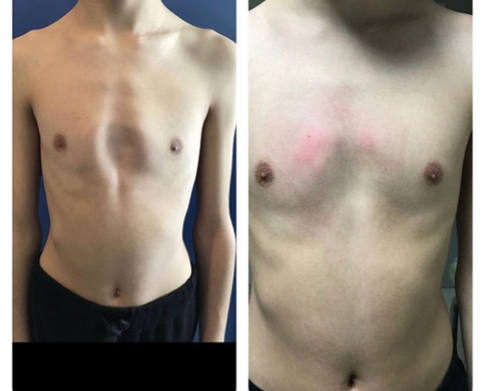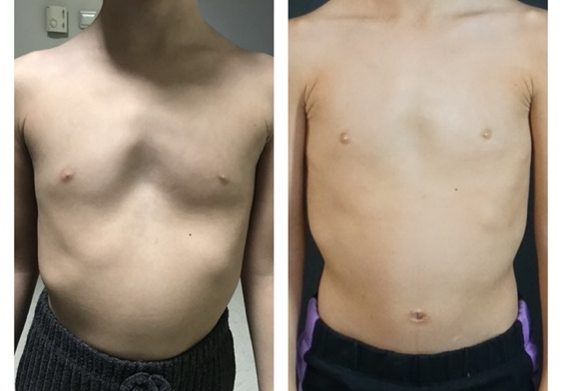
Pectus Arcuatum
Pectus Arcuatum can be roughly considered as a deformity where both pectus carinatum and excavatum are present together. To better comprehend Pectus Arcuatum, it's necessary to have a basic understanding of the anatomy of the normal sternum.
The sternum bone consists of three parts. The uppermost part is called the manubrium, the middle part is the corpus, and the lower part is the xiphoid. These three pieces are connected by immovable joints. However, these parts are not straight but slightly convexly articulated, protruding slightly outward. Therefore, when viewed from the side, the sternum bone shows the classic "banana shape." An ideal chest cage shape should have this "banana shape." The angle between the manubrium and the corpus is referred to as the "angle of Louis" in anatomy. An angle of 162 degrees is considered ideal.

In pectus excavatum or carinatum deformities, the body and xiphoid part of the sternum are usually located more inward or outward than they should be. In Pectus Arcuatum deformity, the manubrium part and the adjacent cartilaginous ribs protrude excessively outward. Not only is there protrusion of the manubrium, but also the Louis angle, which should ideally be 162 degrees, has significantly decreased, forming a sharp corner on the bone and causing the body and tail portion of the bone to be oriented further inward than it should be.

So, as we mentioned at the beginning, it can be considered as a form of deformity where both pectus carinatum and excavatum are observed together. However, Pectus Arcuatum constitutes less than 1% of pectus deformities.

Treatment of Pectus Arcuatum
As a matter of literature knowledge, there is no non-surgical treatment for Pectus Arcuatum. However, since this surgery is not performed before the completion of the growth and development of children, for Pectus Arcuatum deformities detected at a young age, instead of waiting for the child to grow without doing anything, we provide patients with the opportunity for non-surgical correction until they reach adulthood. We have many patients who have benefited from our efforts in this regard.
At Dr. Pectus Clinic, we offer a non-surgical treatment option using both orthotics and vacuum. Typically, the protrusion that is pointed outwards is too rigid to be suppressed by an orthosis. However, our goal is to stop the bone from growing in that direction by applying pressure with the orthosis, allowing the parts not in contact with the orthosis to continue growing. Additionally, we aim to encourage the inwardly depressed part to grow outward by the pulling effect of the vacuum.
By utilizing the ongoing growth and development of the child, we leverage this advantage. As we do not expect immediate results solely from the pressure of the orthosis or the pulling force of the vacuum, this treatment takes a longer period of time (years) to yield results compared to non-surgical treatments we apply for pectus excavatum or carinatum.
The defined surgical treatments for Pectus Arcuatum in the literature are the Ravitch method and the Önen Method, which we have introduced to the literature.














